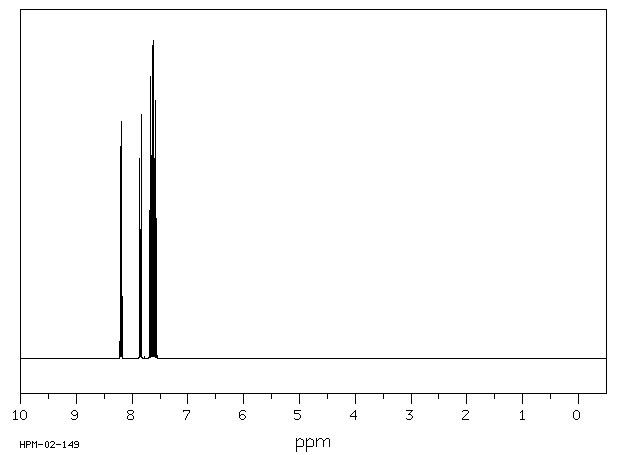四唑并[5,1-b][1,3]苯并噻唑 | 248-02-2
中文名称
四唑并[5,1-b][1,3]苯并噻唑
中文别名
——
英文名称
[1,2,3,4]tetrazole[5,1-b][1,3]benzothiazole
英文别名
tetrazolo <5,1-b> benzothiazole;tetrazolo<5,1-b>benzothiazole;benzo[4,5]thiazolo[3,2-d]tetrazole;benzo[4,5]thiazolo[3,2-d]tetrazole;Benzo[4,5]thiazolo[3,2-d]tetrazol;8-Thia-1.2.3.3a-tetraaza-cyclopentinden;Tetrazolo[5,1-b][1,3]benzothiazole
CAS
248-02-2
化学式
C7H4N4S
mdl
MFCD00227617
分子量
176.202
InChiKey
IUMRBKDMFRMZFM-UHFFFAOYSA-N
BEILSTEIN
——
EINECS
——
-
物化性质
-
计算性质
-
ADMET
-
安全信息
-
SDS
-
制备方法与用途
-
上下游信息
-
文献信息
-
表征谱图
-
同类化合物
-
相关功能分类
-
相关结构分类
计算性质
-
辛醇/水分配系数(LogP):1.8
-
重原子数:12
-
可旋转键数:0
-
环数:3.0
-
sp3杂化的碳原子比例:0.0
-
拓扑面积:71.3
-
氢给体数:0
-
氢受体数:4
安全信息
-
海关编码:2934100090
SDS
反应信息
-
作为反应物:描述:四唑并[5,1-b][1,3]苯并噻唑 在 氯磺酸 、 sodium azide 作用下, 以 乙腈 为溶剂, 反应 3.0h, 生成 2-azido-benzothiazole-6-sulfonyl azide参考文献:名称:Skopenko,V.N. et al., Soviet progress in chemistry, 1977, vol. 43, # 5, p. 73 - 76摘要:DOI:
-
作为产物:描述:参考文献:名称:叠氮基-N-杂芳烃与 Meerwein 试剂的季铵化:2-叠氮基(苯并)咪唑鎓和相关叠氮基-N-杂芳基四氟硼酸盐的直接合成摘要:2-叠氮基(苯并)咪唑鎓盐是通过在环境条件下用 Meerwein 试剂对 2-叠氮基(苯并)咪唑进行季铵化制备的。这种一锅法也适用于 4 或 3-叠氮基吡啶和适当的叠氮基(异)喹啉,以制备相关的叠氮基-N-杂芳基盐。与它们的前体相比,观察到几种代表性叠氮基-N-杂芳烃盐与丙二酸二乙酯反应的重氮转移反应性有所提高。DOI:10.1016/j.tetlet.2022.154063
文献信息
-
Development of benzothiazole ‘click-on’ fluorogenic dyes作者:Jianjun Qi、Ching-Hsuan TungDOI:10.1016/j.bmcl.2010.11.009日期:2011.1'Click-on' fluorogenic reaction: a non-fluorescent benzothiazole with an electron-deficient alkyne group at 2-position reacts with azide containing molecules could form fluorescent adducts. (C) 2010 Elsevier Ltd. All rights reserved.
-
Triazolbenzo[d]thiazoles: Efficient synthesis and biological evaluation as neuroprotective agents作者:Belem Avila、Aaron Roth、Heather Streets、Donard S. Dwyer、Mark J. KurthDOI:10.1016/j.bmcl.2012.07.022日期:2012.9A number of (1H-1,2,3-triazol-1-yl)benzo[d]thiazoles were synthesized utilizing a versatile Cu-catalyzed azide–alkyne click reaction (CuAAC) on tautomeric benzo[4,5]thiazolo[3,2-d]tetrazole (1) and 2-azidobenzo[d]thiazole (2) starting materials. Moreover, one of the resulting products of this investigation, triazolbenzo[d]thiazole 22, was found to possess significant neuroprotective activity in human
-
On the utility of the azido transfer protocol: synthesis of 2- and 5-azido N-methylimidazoles, 1,3-thiazoles and N-methylpyrazole and their conversion to triazole–azole bisheteroaryls作者:Paolo Zanirato、Stefano CeriniDOI:10.1039/b500634a日期:——The azido transfer procedure of heteroaryllithium and tosyl azide was used to synthesize selected 2- and 5-azidoazoles. This procedure, which is based on the fragmentation of the appropriate lithium triazene salts 1aâ7a, successfully afforded 2-azido-N-methylimidazole 1, 2-azido-1,3-thiazole 2, 2-azidobenzo-1,3-thiazole 3, 5-azido-N-methylpyrazole 4, 5-azido-N-methylimidazole 6 [via 2-(trimethylsilyl)-5-azido-N-methylimidazole 5], and 5-azido-1,3-thiazole 7 (via 5-lithio-1,3-thiazole), but attempts to prepare 5-azido-2-(trimethylsilyl)-1,3-thiazole 8 from the corresponding triazene 7a failed, affording only the desilylated azide 7 in poor yield. Azides 1â7 underwent 1,3-dipolar cycloaddition when mixed with neat (trimethylsilyl)acetylene, giving 1-heteroaryl-4-trimethylsilyl-1,2,3-triazoles 1bâ7b generally in very high yields.利用杂芳基锂和对甲苯基叠氮化物的叠氮转移程序合成了部分 2-和 5-叠氮唑。该步骤基于适当的三氮烯锂盐 1aâ7a 的碎裂,成功地得到了 2-叠氮-N-甲基咪唑 1、2-叠氮-1,3-噻唑 2、2-叠氮苯并-1,3-噻唑 3、5-叠氮-N-甲基吡唑 4、5-叠氮-N-甲基咪唑 6 和 5-叠氮-N-甲基咪唑 7、但从相应的三嗪 7a 中制备 5-叠氮-2-(三甲基硅基)-1,3-噻唑 8 的尝试失败了,只得到了脱硅叠氮化物 7,收率很低。叠氮化物 1â7 与纯净的(三甲基硅基)乙炔混合后发生 1,3-二极环加成反应,得到 1-heteroaryl-4- 三甲基硅基-1,2,3-三唑 1bâ7b,收率通常非常高。
-
Iron-Catalyzed Intermolecular Amination of Benzylic C(sp<sup>3</sup>)–H Bonds作者:Hillol Khatua、Subrata Das、Sima Patra、Sandip Kumar Das、Satyajit Roy、Buddhadeb ChattopadhyayDOI:10.1021/jacs.2c10719日期:2022.12.7intermolecular benzylic C(sp3)–H amination is developed utilizing 1,2,3,4-tetrazole as a nitrene precursor via iron catalysis. This method enables direct installation of 2-aminopyridine into the benzylic and heterobenzylic position. The method selectively aminates 2° benzylic C(sp3)–H bond over the 3° and 1° benzylic C(sp3)–H bonds. Experimental studies reveal that the C(sp3)–H amination undergoes via the formation
-
Iron-Catalyzed Intermolecular C–N Cross-Coupling Reactions via Radical Activation Mechanism作者:Subrata Das、Andreas W. Ehlers、Sima Patra、Bas de Bruin、Buddhadeb ChattopadhyayDOI:10.1021/jacs.3c05627日期:2023.7.12aromatic and aliphatic azides with boronic acids under iron-catalyzed conditions. The amination follows an unprecedented metalloradical activation mechanism that is different from traditional metal-catalyzed C–N cross-coupling reactions. The scope of the reaction has been demonstrated by the employment of a large number of tetrazoles, azides, and boronic acids. Moreover, several late-stage aminations
表征谱图
-
氢谱1HNMR
-
质谱MS
-
碳谱13CNMR
-
红外IR
-
拉曼Raman
-
峰位数据
-
峰位匹配
-
表征信息
同类化合物
(1Z)-1-(3-乙基-5-羟基-2(3H)-苯并噻唑基)-2-丙酮
齐拉西酮砜
齐帕西酮-d8
阳离子蓝NBLH
阳离子荧光黄4GL
锂2-(4-氨基苯基)-5-甲基-1,3-苯并噻唑-7-磺酸酯
铜酸盐(4-),[2-[2-[[2-[3-[[4-氯-6-[乙基[4-[[2-(硫代氧代)乙基]磺酰]苯基]氨基]-1,3,5-三嗪-2-基]氨基]-2-(羟基-kO)-5-硫代苯基]二氮烯基-kN2]苯基甲基]二氮烯基-kN1]-4-硫代苯酸根(6-)-kO]-,(1:4)氢,(SP-4-3)-
铜羟基氟化物
钾2-(4-氨基苯基)-5-甲基-1,3-苯并噻唑-7-磺酸酯
钠3-(2-{(Z)-[3-(3-磺酸丙基)-1,3-苯并噻唑-2(3H)-亚基]甲基}[1]苯并噻吩并[2,3-d][1,3]噻唑-3-鎓-3-基)-1-丙烷磺酸酯
邻氯苯骈噻唑酮
西贝奈迪
螺[3H-1,3-苯并噻唑-2,1'-环戊烷]
螺[3H-1,3-苯并噻唑-2,1'-环己烷]
葡萄属英A
草酸;N-[1-[4-(2-苯基乙基)哌嗪-1-基]丙-2-基]-2-丙-2-基氧基-1,3-苯并噻唑-6-胺
苯酰胺,N-2-苯并噻唑基-4-(苯基甲氧基)-
苯酚,3-[[2-(三苯代甲基)-2H-四唑-5-基]甲基]-
苯胺,N-(3-苯基-2(3H)-苯并噻唑亚基)-
苯碳杂氧杂脒,N-1,2-苯并异噻唑-3-基-
苯甲酸,4-(6-辛基-2-苯并噻唑基)-
苯甲基2-甲基哌啶-1,2-二羧酸酯
苯并噻唑正离子,2-[3-(1,3-二氢-1,3,3-三甲基-2H-吲哚-2-亚基)-1-丙烯-1-基]-3-乙基-,碘化(1:1)
苯并噻唑正离子,2-[2-[4-(二甲氨基)苯基]乙烯基]-3-乙基-6-甲基-,碘化
苯并噻唑正离子,2-[(2-乙氧基-2-羰基乙基)硫代]-3-甲基-,溴化
苯并噻唑啉
苯并噻唑三氯金(III)
苯并噻唑-d4
苯并噻唑-7-乙酸
苯并噻唑-6-腈
苯并噻唑-5-羧酸
苯并噻唑-5-硼酸频哪醇酯
苯并噻唑-4-醛
苯并噻唑-4-乙酸
苯并噻唑-2-磺酸钠
苯并噻唑-2-磺酸
苯并噻唑-2-磺酰氟
苯并噻唑-2-甲醛
苯并噻唑-2-甲酸
苯并噻唑-2-甲基甲胺
苯并噻唑-2-基磺酰氯
苯并噻唑-2-基甲基-乙基-胺
苯并噻唑-2-基叠氮化物
苯并噻唑-2-基-邻甲苯-胺
苯并噻唑-2-基-己基-胺
苯并噻唑-2-基-(4-氯-苯基)-胺
苯并噻唑-2-基-(4-氟-苯基)-胺
苯并噻唑-2-基-(4-乙氧基-苯基)-胺
苯并噻唑-2-基-(2-甲氧基-苯基)-胺
苯并噻唑-2-基-(2,6-二甲基-苯基)-胺







